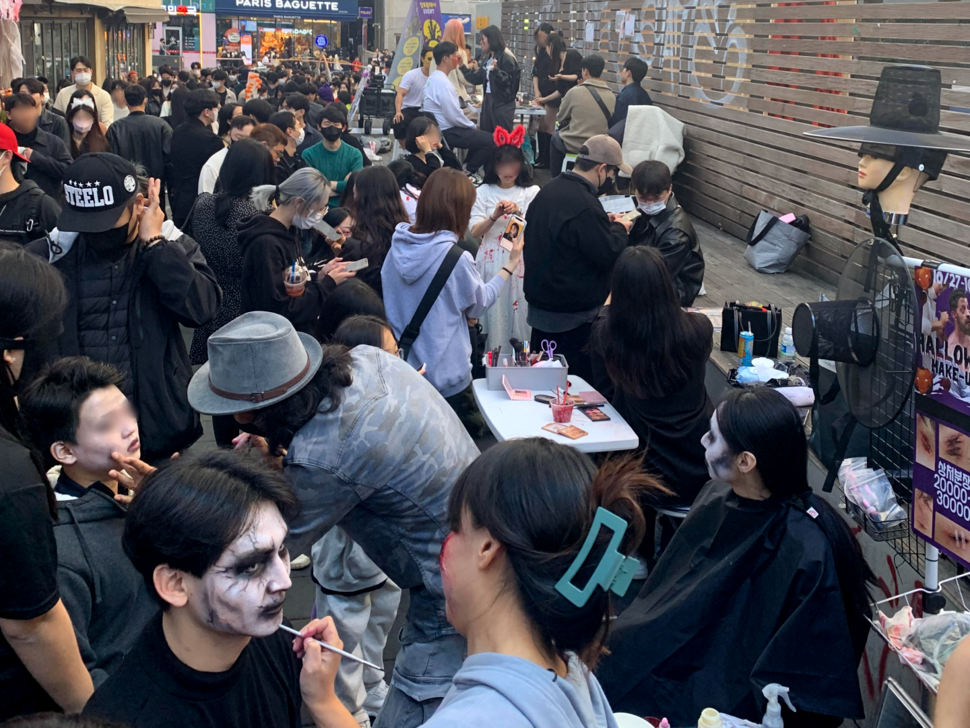hankyoreh
Links to other country sites 다른 나라 사이트 링크
[Guest essay] Itaewon Halloween crowd crush: From Hell Joseon to urban nightmare


By John R. Eperjesi, professor of English linguistics and literature at Kyung Hee University
I’ve lived in Kyungridan (Gyeongnidan), the neighborhood next to Itaewon, for about eight years now. I walk through Itaewon almost every day when I go to my favorite restaurant and coffee shop. I have several friends who are business owners in Itaewon. I rarely left this neighborhood during the pandemic. This is home.
The horrific deaths of 158 people gathered in Itaewon for Halloween, many of them in their teens and early 20s, has shocked, saddened, and angered our community while dividing the nation. Similar to the aftermath of the criminal sinking of the Sewol ferry, the mass-casualty event in Itaewon has led to victim-blaming, scapegoating, political infighting, lawsuits, arrests, and suicides. Many of my Korean friends and students have told me that they feel disgusted with Korea right now.
I walked through Itaewon on the fateful night of Halloween festivities around 5:30 pm. Around this time of year, makeup artists line the alleys around the Hamilton Hotel, and I love watching them put nasty scars and gaping wounds on young peoples’ eager faces. Early on, it’s an all-ages affair, lots of parents with their kids tricked out in cute costumes, groups of high school students in their school uniforms drenched in blood — unsubtle commentary on the oppressive education system here — and as day turns to night, the freaks come out. Itaewon on Halloween is fun. People travel to Korea just to be in Itaewon on Halloween.
I’ve strolled through Itaewon on Halloween every year for the past 15 years, and every year the costumes get more intense, and the carnivalesque atmosphere gets more joyfully chaotic, giving young Koreans a chance to temporarily escape the neoliberal nightmare — dismal job market, debt, skyrocketing rent — that they call Hell Joseon.
In an article published on New Year’s Eve, 2019, just before the pandemic turned the planet upside down, Andrew Salmon reported, “A catchphrase has become current among young Koreans in recent years to describe their country: ‘Hell Joseon’ – ‘Joseon’ being the name of a long-dead Korean kingdom. That phrase is being superseded by a new term, ‘Tal-Jo’ – a pormanteau comprising ‘leave’ and ‘Joseon,’ which, vernacularly, might be best be translated as ‘Escape Hell.’”
Salmon cites a Hankyoreh survey which “found that 79.1% of young women and 72.1% of young men want to leave Korea, that 83.1% of young women and 78.4% of young men consider Korea ‘hell’ and that 29.8% of young women and 34.1% of young men consider themselves ‘losers.’”
This survey came out around the same time as Bong Joon-ho’s “Parasite,” a pre-pandemic indictment of the precarity, social exclusion, and hopelessness that pervades the lives of many Koreans, especially the young and the elderly.
“Squid Game,” which appeared during the pandemic, upped the ante on “Parasite,” offering a brutal exposé of the crushing debt, violent individualism, and cutthroat competition that dominates Korean society. There has been a lot of hand-wringing in Korea over the question of why Halloween has been embraced so enthusiastically by young Koreans. One obvious reason is that Halloween in Itaewon allows young Koreans to temporarily escape Hell Joseon, to leave Korea without leaving Korea.
In addition to its local popularity, Halloween in Itaewon has become a massive international gathering that has been growing exponentially every year. The pandemic had slowed things down, so of course this year’s festivities — the first in years without COVID-19 curbs in place — were going to be bigger than ever.
While Halloween in Itaewon has been expanding, the alleyways around the Hamilton Hotel, the center of the action, have been contracting, undergoing rapid, noisy, gaudy overdevelopment, creating a dense urban space designed to suck as much profit out of partygoers as possible, with little to no concern for their safety. Many survivors of the crowd crush report that the blaring music from the open-air bars made the chaos much worse. Why didn’t venues turn their music off when they saw the emergency unfolding? Perhaps they were too busy hovering over their cash registers.
In an article for Curbed, Se-woong Koo argues that overdevelopment in the alleyways around the Hamilton Hotel created spatial conditions that were a disaster waiting to happen.
“Over the past several days, it’s become clear how rampant development contributed to the tragedy. On the corner, the Hamilton Hotel itself had built unpermitted structures, including a temporary metal wall, a booth, and a terrace, narrowing the lane even further in the choke point where so many lives were lost,” Koo writes.
“The local district office allegedly ordered the Hamilton to remove these structures over the years, but the hotel kept on using the space, taking away precious breathing room that could have allowed more people to survive. Other businesses in the vicinity also constructed illegal terraces that jutted out into the street, making the walkway even narrower than it should have been,” he goes on. “Again, there was no serious enforcement against these ad hoc additions, which compounded the fatalities that night.”
When I walked through Itaewon at 5:30 pm that day, the alleys around the Hamilton Hotel were already packed. I texted a friend and said that they really needed to block off the main street. One friend who is a local business owner told me that they have been saying that the main street needed to be closed off to cars on Halloween for years, but there is a total disconnect between the local government office and local businesses.
Everyone in Itaewon takes Halloween very seriously, from the venues that spend large amounts of money on spooky decorations, to the revelers who spend large amounts of time and energy on their costumes. The only people who did not take the Itaewon Halloween gathering seriously were the officials responsible for public safety, and 158 people, many of them in their teens and early 20s, paid the price. If officials had barred cars from entering Itaewon on Oct. 29, providing a safety valve for the flow of people coming out of the subway station, 158 families would not be in mourning right now.
We were reading Ernest Callenbach’s “Ecotopia” in my Environmental Literature class last week, so I asked my students to think about the relationship between the novel’s utopic vision of urban planning and the mass-casualty event in Itaewon. Could something like this happen in “Ecotopia”? When the narrator, William Weston, visits the new San Francisco for the first time, he is shocked.
“I expected to encounter something at least a little like the exciting bustle of our cities–cars honking, taxis swooping, clots of people pushing about in the hurry of urban life,” Weston remarks. “What I found, when I had gotten over my surprise at the quiet, was that Market Street, once a mighty boulevard striking through the city down to the waterfront, has become a mall planted with thousands of trees.”
Instead of cars and traffic and noise and pollution, the main street through new San Francisco is filled with gardens, fountains, flowers, sculptures, benches and bike paths. Birdsong fills the air. Callenbach immerses readers in a carless city, which made me think that maybe something similar should be done in Itaewon. Itaewon needs to calm down a little bit, and nothing is more calming than nature.
There is going to be a lot of discussion in the coming months about what should be done in Itaewon, about what the future will look like. A carless Itaewon should be on the table. Nobody wants Itaewon to die. Itaewon has given a lot of joy to people over the years, and I am confident that people will come back to support the neighborhood.
The most important question is how the neighborhood can be reimagined in a way that is respectful to and honors the deceased and their grieving families while respecting the voices and needs of local business owners. If they had been listened to in the first place, this awful disaster never would have happened.
Please direct questions or comments to [english@hani.co.kr]
Editorial・opinion
![[Guest essay] Preventing Korean Peninsula from becoming front line of new cold war [Guest essay] Preventing Korean Peninsula from becoming front line of new cold war](https://flexible.img.hani.co.kr/flexible/normal/500/300/imgdb/original/2024/0507/7217150679227807.jpg) [Guest essay] Preventing Korean Peninsula from becoming front line of new cold war
[Guest essay] Preventing Korean Peninsula from becoming front line of new cold war![[Column] The state is back — but is it in business? [Column] The state is back — but is it in business?](https://flexible.img.hani.co.kr/flexible/normal/500/300/imgdb/original/2024/0506/8217149564092725.jpg) [Column] The state is back — but is it in business?
[Column] The state is back — but is it in business?- [Column] Life on our Trisolaris
- [Editorial] Penalties for airing allegations against Korea’s first lady endanger free press
- [Editorial] Yoon must halt procurement of SM-3 interceptor missiles
- [Guest essay] Maybe Korea’s rapid population decline is an opportunity, not a crisis
- [Column] Can Yoon steer diplomacy with Russia, China back on track?
- [Column] Season 2 of special prosecutor probe may be coming to Korea soon
- [Column] Park Geun-hye déjà vu in Yoon Suk-yeol
- [Editorial] New weight of N. Korea’s nuclear threats makes dialogue all the more urgent
Most viewed articles
- 1Yoon’s broken-compass diplomacy is steering Korea into serving US, Japanese interests
- 2[Guest essay] Preventing Korean Peninsula from becoming front line of new cold war
- 3South Korean ambassador attends Putin’s inauguration as US and others boycott
- 4Behind-the-times gender change regulations leave trans Koreans in the lurch
- 5Family that exposed military cover-up of loved one’s death reflect on Marine’s death
- 6Yoon’s revival of civil affairs senior secretary criticized as shield against judicial scrutiny
- 7Japan says its directives were aimed at increasing Line’s security, not pushing Naver buyout
- 8Marines who survived flood that killed colleague urge president to OK special counsel probe
- 9Amid US-China clash, Korea must remember its failures in the 19th century, advises scholar
- 10‘Weddingflation’ breaks the bank for Korean couples-to-be